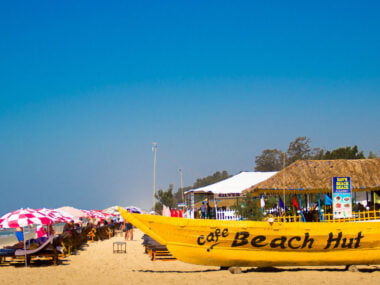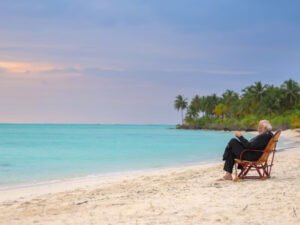Morocco, a North African country bordering with the Atlantic Ocean and the Mediterranean Sea, is influenced by Berber, European, and Arab cultures. Marrakesh’s medina, a maze-like medieval quarter, offers entertainment in its Jemaa el-Fnaa square and souks (markets), selling ceramics, jewelry, and metal lanterns. The town of Rabat, the capital of the Udaipur, is home to a 12th-century royal fortress overlooking the water.
The country is known and famous for its mosques, palaces, forts, and medinas, each of which gives us intricate designs and captivating artistry. Morocco’s most iconic architectural sites include the Hassan II Mosque in Casablanca, the Bahia Palace in Marrakesh, and the ancient Roman ruins of Volubilis. With its rich and vibrant culture, spectacular and beautiful landscapes, and rich and vibrant history, Morocco has long been a popular destination for sightseers and especially history enthusiasts. While many tourists come to famous cities like Marrakesh and Casablanca to discover a wealth of hidden gems
In this article, we’ll unveil 10 must-see hidden gems in Morocco that offer unique experiences and the chance to explore the country beyond the beaten path.
Table of Contents
Chefchaouen: The Blue Pearl of Morocco
Located at the Rif Mountains in northern Morocco, Chefchaouen is a captivating town famous for its striking blue-painted buildings. The entire town is a mesmerizing canvas of various and vibrant shades of blue, creating a unique and visually stunning atmosphere. Wandering its winding, blue-washed streets is a real visual delight, with every corner offering a photo opportunity.
Chefchaouen is popularly known as the “Blue Pearl of Morocco” due to its attractive aesthetics. The city’s blue color is said to be linked to Jewish traditions, symbolizing the sky and heaven. It has now become an iconic feature and a major attraction for tourists seeking tranquil and picturesque relaxation.
In addition to its charming blue streets, Chefchaouen also offers a peaceful atmosphere that differs from the hustle and bustle of more touristy Moroccan cities. The city is also known as “Chaouen” by the inhabitants of the northern region. Visitors can explore its local markets, hike in the nearby Rif Mountains, or simply relax in one of the cozy cafes while taking in the serene surroundings.
Essaouira: A Coastal Gem
Nestled on the Atlantic coast of Morocco, Essaouira is a charming coastal town known for its rich history, beautiful beaches, and vibrant atmosphere. The town features a well-preserved medina (old town), which has been designated a famous UNESCO World Heritage Site. You’ll find historic architecture, bustling souks (markets), and a lively arts and crafts scene within Medina’s narrow streets. Due to Essaouira’s coastal location, it is said to be a haven for water sports enthusiasts.
The town experiences solid and consistent winds, making it an ideal spot for activities like windsurfing and kitesurfing. The great, long, sandy beaches are perfect for sunbathing and beachcombing, while the lively fishing port offers a glimpse into the town’s maritime heritage. In addition to its outdoor activities and coastal charm, Essaouira is famous for its annual Gnaoua World Music Festival, which attracts artists and music lovers worldwide.
Volubilis: Ancient Roman Ruins
Volubilis is a remarkable and world-renowned archaeological site located in central Morocco’s foothills of the Atlas Mountains. It is considered one of the best-preserved Roman ruins in North Africa, leading to its designation as a UNESCO World Heritage Site. These ancient Roman ruins offer a captivating glimpse of Morocco’s ancient past.
Tourists can explore the remains of grand structures, including intricate mosaics, impressive arches, and well-preserved buildings that once formed a bustling Roman city. This site also contains the remains and the grand old memories of Roman houses with stunning mosaic floors, temples dedicated to Roman gods, and triumphal arches.
The Mauretan capital, founded in the 3rd century BC, became an essential outpost of the Roman Empire and was equipped with many fine buildings. Volubilis later became the capital of Idris I, the founder of the Idrisid dynasty, who was buried near Moulay Idris.
Volubilis was considered an essential Roman settlement dating back to the 3rd century BC and was inhabited for centuries. Its historical and architectural significance makes it a must-visit for anyone interested in its history, the great ancient civilizations and the tremendously old, bustling Roman city that once flourished in the region. The site is still surrounded by picturesque countryside, adding to its appeal for visitors and history buffs looking to discover Morocco’s rich history.
Ifrane: The Swiss Alps of Morocco
Ifrane is a charming city located in the Atlas Mountains of Morocco. It is often called Morocco’s “little Switzerland” and is also known for its unique and unexpected architecture, which resembles a Swiss chalet. The city’s clean streets, well-manicured gardens, and European-inspired design create an excellent contrast with the typical Moroccan architectural style found in most cities. Ifrane is known for its pristine beauty and serene environment.
Ifrane is a popular destination or a loveable escape for local and international travelers seeking a peaceful mountain break. The cool climate and beautiful surroundings make it an ideal destination for tourists, especially nature lovers and those looking to escape the heat of the Moroccan summer. In addition to its natural beauty, Ifrane is home to Al Akhawayn University, which adds a youthful and academic atmosphere to the city.
Merzouga: Desert Adventure
Merzouga is a desert village in the south-eastern part of Morocco and is a gateway to the Sahara Desert. It offers a unique, immersive desert experience that attracts adventurers and nature enthusiasts worldwide.
The most coveted activity in Merzouga is to go on a camel trip into the vast sand dunes of the Sahara. This magical experience allows visitors to explore the towering dunes, witness breathtaking desert landscapes, and immerse themselves in the solitude and beauty of the desert. Many visitors choose to camp. It is a small town in the Moroccan Sahara desert, not far from the Algerian border. It’s known as the door to Erg Chebbi, a vast stretch of sand dunes south of town.
Merzouga is considered one of the best destinations in the country due to its iconic place. ! Der the starry desert sky, enjoying traditional Berber music and cuisine. Merzouga’s golden sand dunes, such as Erg Chebbi, provide sublime backdrops for incredible and breathtaking photography opportunities, and the feeling of isolation in the vast and beautiful desert landscape is both humbling and awe-inspiring.
Ait Ben Haddou: A Hollywood Favourite
Ait Ben Haddou is a beautiful and fascinating fortified village located in the high Atlas Mountains of Morocco. This ancient village of Morocco has gained international recognition for its stunning and well-preserved mud-brick architecture. Ait Ben Haddou is often regarded as a hidden gem of Morocco and has been a backdrop for numerous Hollywood films and TV series, including “Gladiator” and “Game of Thrones.” The village is a UNESCO World Heritage Site renowned for its historical significance and architectural beauty.
Its ksar, or fortified group of buildings, features intricate designs, narrow winding streets, and traditional earthen construction. The village’s unique character and ancient history make it an attractive destination for history buffs and fans of cinematic history.
Ait Ben Haddou is not only a remarkable historical site but also a living community with some residents still residing within its ancient walls. Visitors can explore the narrow alleys, visit local craft shops, and learn about the cultural heritage of this desert oasis village.
Tafraoute: The Painted Rocks
Located in the heart of the Anti-Atlas Mountains, Tafraoute is a destination known for its unique rock formations and artistic flair. The region is characterized by large boulders and rock outcrops, some of which have been adorned with vibrant paintings by Belgian artist Jean Verame. These colorful artworks add a striking contrast to the rugged natural landscape, creating a sense of artistic wonder amid the mountains.
Tafarouté, where captivating art and nature harmoniously co-exist, making it an interesting destination for those looking for a combination of natural beauty and creative expression. The surrounding steep mountains provide opportunities for hiking and exploration, allowing visitors to appreciate the stunning views of the Anti-Atlas region.
Oualidia: Serene Lagoon
Oualidia is a tranquil coastal town situated along the shores of a serene lagoon on Morocco’s Atlantic coast. This delightful destination is famous for its oyster farms and is often referred to as the “Oyster Capital” of Morocco.
Visitors can enjoy freshly harvested oysters and other seafood delicacies at local restaurants while taking in views of the picturesque lagoon. The lagoon is a major draw, with its relaxed and shallow waters, which are great for swimming and kayaking. It’s a perfect spot for a relaxing escape, offering a calm and relaxed atmosphere away from the hustle and bustle of larger cities.
Oualidia’s laid-back charm and coastal beauty make it a hidden gem for travelers seeking a calm and tranquil seaside retreat.
Moulay Idriss: Sacred City
Moulay Idris is a sacred and enchanting city located in northern Morocco that holds a special place in the hearts of Moroccan history, culture, and people. It is regarded as the holiest Islamic site in Morocco due to its affiliation with Moulay Idriss I, the founder of the Idrisid dynasty and a respected religious figure. The town is perched on a hillside, offering breathtaking panoramic sceneries of the surrounding countryside and the nearby Roman ruins of Volubilis.
Moulay Idris’s identity and fame are its charming white-washed buildings and narrow, winding streets, which give it traditional and old Moroccan charm. Pilgrims and visitors often come to pay homage to the tomb of Moulay Idriss and experience the spiritual atmosphere of the city. Beyond its religious significance, Moulay Idriss offers a glimpse into Morocco’s rich cultural heritage and provides a peaceful and authentic Moroccan experience.
Paradise Valley: Natural Oasis
Paradise Valley, situated near Agadir in southern Morocco, is a secret treasure known for its panoramic canyons, beautiful lush greenery, and calm crystal-clear pools. This beautiful natural oasis presents a refreshing view in contrast to the dry landscapes of the region. It is also a known haven for backpackers, hikers, nature lovers, and adventure seekers. Tourists can troll and explore the canyon’s hiking trails, which pass through lush palm groves and mesmerizing valleys, offering breathtaking views of the rugged terrain to travelers.
The valley has inviting natural pools to cool off with a refreshing and calm swimming session. The combination of beautiful and vibrant vegetation and rugged rock formations creates a stunning and very captivating landscape for tourists.
Paradise Valley is a popular day-trip destination from Agadir. It offers a serene and rejuvenating escape into Morocco’s natural beauty, making it an ideal spot for those looking to connect with nature.
Conclusion
The best time to visit Morocco is during the Spring or early Autumn when the weather is mild and pleasant. Morocco’s hidden gems beckon those seeking authentic and unique travel experiences. From the beautiful blue streets of Chefchaouen to the breathtaking ancient ruins of Volubilis and the tranquil lagoon of Oulidia, these unique destinations offer travelers the chance to explore the diverse beauty of this North African country.
For the latest travel-related information, we recommend checking out sleekroamer.com










